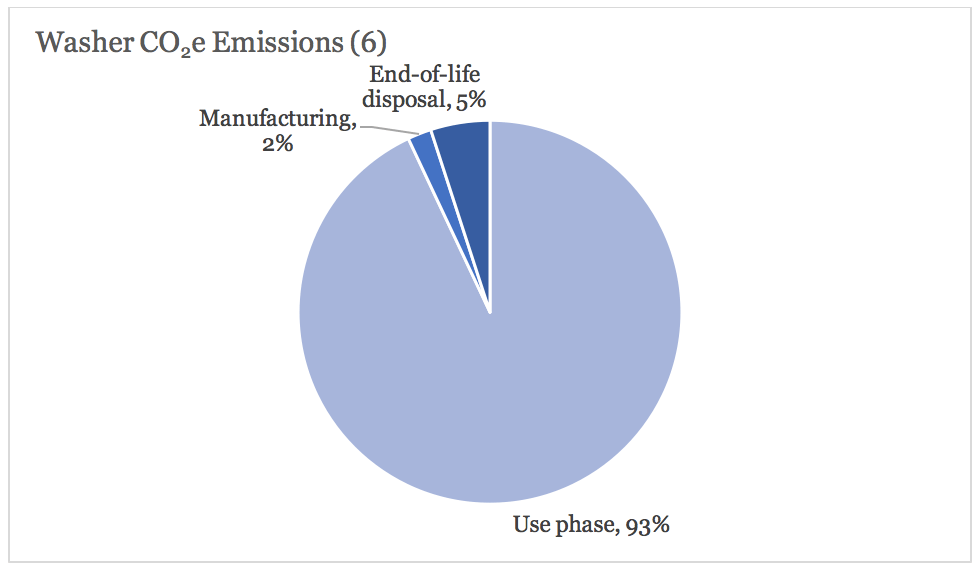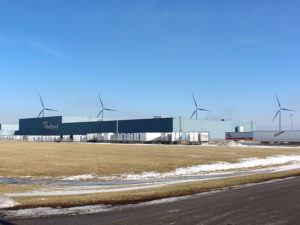Whirlpool: A STAR among appliance companies

Whirlpool has led the way in climate change initiatives among appliance manufacturers.
“It happened” begins a 2014 article in Consumer Reports magazine – a clothes dryer had finally received ENERGY STAR status. The manufacturer? Whirlpool Corporation. (6) It’s just the latest major development in Whirlpool’s long list of energy-related accolades – the company has been focused on environmental initiatives since at least 1970.
The first clothes dryer to receive the ENERGY STAR label was manufactured by Whirlpool.
Leading the Way: Early Efforts to Reduce Carbon Impact
Michigan-based Whirlpool Corporation is the leading manufacturer of household appliances with 2015 revenue of $21Bn. Its largest brands include Whirlpool, KitchenAid, and Maytag (3). Whirlpool first began focusing on its environmental impact in 1970 when it created a corporate office for environmental control (4). At first, its efforts were focused on improving the carbon footprint of its manufacturing operations. But the emissions used to manufacture a product are small compared the emissions required for consumers to use the product at home. The potential impact for Whirlpool was huge – in the U.S., nearly 17% of greenhouse gas emissions come from residential energy use (1). Indeed, in the 1990s, Whirlpool began to shift focus to the energy efficiency of its products.
In 1996, Whirlpool began voluntary participation in the ENERGY STAR label (2), a “seal of approval” for energy-efficient products launched by the Environmental Protection Agency (5). Requirements for a product to receive the ENERGY STAR designation are specified by product type. For example, ENERGY STAR clothes washers are approximately 25% more efficient than non-certified models (2). Whirlpool’s choice to pursue ENERGY STAR status is not purely altruistic. Studies find that consumers are willing to pay significantly more for an appliance with an ENERGY STAR designation – stemming from both consumer concern for the environment and personal energy cost savings. (1) Whirlpool Corporation has received 37 ENERGY STAR Awards in North America alone since 1998. (9)
The ENERGY STAR Label is a seal of approval issued by the EPA
Ongoing Focus on Impact
At the 2003 Conference of the Parties of the Kyoto Protocol, Whirlpool became the first appliance manufacturer to announce a comprehensive program to cut greenhouse gas emissions and committed to reduce its impact by 3%. The program would be focused on increasing energy efficiency of its appliances, but attention would also be paid to manufacturing and end-of-lif. As illustrated in the chart below, the vast majority of appliance carbon impact comes from the home use phase.
In a press release, Whirlpool took a strong stance on its plan to combat climate change. “Whatever political solution the global community agrees on with regard to the best mechanism for collectively addressing climate change, our company will continue its efforts to do our part, while at the same time bring unique, innovative and energy-efficient products to our customers,” said Tom Catania, Whirlpool’s vice president of government relations. (7)
The Way Forward
In recent years, Whirlpool has incorporated additional measures to reduce its impact on the climate. For example, they are currently building a wind farm near its Findlay, Ohio plant which will meet 22% of the plant’s electric needs. (8) It has also committed to zero landfill manufacturing waste by 2022 and has created an appliance recycling program, resulting in nearly 90,000 recycled appliances. (9)
A rendering of the forthcoming wind farm in Ohio
Going forward, how should Whirlpool continue to reduce its impact on climate change? The biggest change I would recommend is to continue to increase the percentage of products that are ENERGY STAR labeled. Of the 34 Whirlpool Corporation washers sold on sears.com, 30% are not compliant (10). Given that 93% of washer emissions occur during the use phase, this change should be the highest priority. Second, Whirlpool should increase its reliance on renewable energy. The wind farm in Ohio is a good first step, but Whirlpool should take a more aggressive approach to its utilization of both wind and solar energy. Although Whirlpool has made major strides in its own manufacturing, there is not a major focus on the sustainability of its suppliers – more diligence there is another opportunity.
In the sphere of household appliances, Whirlpool Corporation has been a model for increasing energy efficiency and has taken its impact on climate change seriously. Hopefully this is an effort that continues to be a priority for the company. (709 words)
(1) Factors influencing willingness-to-pay for the ENERGY STAR® label . 2016. Factors influencing willingness-to-pay for the ENERGY STAR® label . [ONLINE] Available at: http://www.sciencedirect.com/science/article/pii/S0301421510009171. [Accessed 04 November 2016].
(2) About ENERGY STAR | ENERGY STAR. 2016. About ENERGY STAR | ENERGY STAR. [ONLINE] Available at: https://www.energystar.gov/about. [Accessed 04 November 2016].
(3)Whirlpool Corporation. 2015. Whirlpool Corporation 2015 Annual Report. [ONLINE] Available at: http://assets.whirlpoolcorp.com/wp-content/uploads/WhirlpoolCorporation-AnnualReport2015.pdf. [Accessed 1 November 2016].
(4)The Environment – Whirlpool MEA. 2016. The Environment – Whirlpool MEA. [ONLINE] Available at: http://mea.whirlpool.com/discover-whirlpool/sustainability/the-environment. [Accessed 04 November 2016].
(5) Government Will Offer Seal For Energy-Efficient Products. The New York Times, Retrieved from www.lexisnexis.com/hottopics/lnacademic
(6)Whirlpool Dryer: First Energy Star Dryer – Consumer Reports News. 2016. Whirlpool Dryer: First Energy Star Dryer – Consumer Reports News. [ONLINE] Available at: http://www.consumerreports.org/cro/news/2014/06/first-energy-star-dryer-saves-energy-and-money/index.htm. [Accessed 04 November 2016].
(7)Whirlpool Corp. to Cut Greenhouse Gas Emissions by 3 Percent from 1998 Levels | Business Wire. 2016. Whirlpool Corp. to Cut Greenhouse Gas Emissions by 3 Percent from 1998 Levels | Business Wire. [ONLINE] Available at: http://www.businesswire.com/news/home/20031210005389/en/Whirlpool-Corp.-Cut-Greenhouse-Gas-Emissions-3. [Accessed 04 November 2016].
(8) Whirlpool Corporation. 2015. Make Earth Day Matter Infographic. [ONLINE] Available at:http://assets.whirlpoolcorp.com/wp-content/uploads/Make-Earth-Day-Matter-Infographic.pdf. [Accessed 1 November 2016].
(9) Whirlpool Corporation. 2015. Whirlpool 2015 Sustainability Report. [ONLINE] Available at:http://assets.whirlpoolcorp.com/files/Whirlpool_2015_CSR_102716.pdf. [Accessed 1 November 2016].
(10) http://www.sears.com/appliances-washers/b-1101269?Brand=Maytag&Brand=Whirlpool&filterList=Brand








Emily, this is a great example of something that is a win-win-win: great for the company (more sales), great for the consumer (lower energy costs), and great for the environment (reduced emissions). Its easy to celebrate the progress Whirlpool has made in bringing energy conservation to home appliances, but I agree with your sentiment that it should be doing more. I think your suggestions are a start, but I also think that given consumers really drive the most energy use, perhaps Whirlpool can be doing more to change consumer behaviors through education such as encouraging lower temperature drying or less frequent and larger loads. I’m sure it will be difficult, but I’d like to see Whirlpool doing more to educate and influence consumers.
That’s a great point, Cara. I agree that there is absolutely more that can be done to change consumer behaviors. I also think there is an opportunity for the EPA / ENERGY STAR to participate in this effort too. Another idea is to engage companies that make detergent or other complementary products to include these types of suggestions on their packaging.
Emily, I am impressed by Whirlpool’s 40+ years of dedication to the environment, but I agree there is always room for innovation! I wonder why Whirlpool has yet to convert its whole product suite to Energy Start status (especially because as Cara mentioned above, it should be win, win, win!) Is Whirlpool unwilling to sacrifice a lower-paying segment of the market in order to make that switch? Will Whirlpool reap enough benefits to justify this transition? When (if ever) should corporations make tradeoffs between sales and environmental responsibility?
Further, this article reminded me that the shift to using clothes dryers is relatively recent. Clothes dryers were first created in the 1940s but did not become widely accessible (due to cost) in US homes until the final quarter of the 21st century. It’s interesting to consider that effective ad campaigns and pricing by Whirlpool and its competitors helped drive this overutilization of resources. Now that we are all hooked on the convenience of dryers, it likely wouldn’t be worthwhile for environmental lobbyists attempt to to reverse our behaviors and revert to the seemingly archaic behavior of air-drying clothes. It reminded me of the inventor of Keurig K-Cups who regretted ever coming up with the idea…
Thanks for sharing! It’s a great point that the most energy-effective solution of all is to dry clothes outside helped along by our good friend wind. It even has the added benefit of a great and fresh scent!
Emily, awesome take on Whirlpool’s efforts. Whirlpool is an interesting example of a company whose environmental impact is tangential. Businesses with heavy carbon emissions can connect a straight line between their business operations and their environmental impact. With Whirlpool, consumers play more of an active role in dictating if Whirlpool’s energy efficient products will have an impact. I looked on Sears.com and found that, not surprisingly, the non-energy saving washers were at the lowest price point. Sometimes there was more than a $100 price difference between the non-energy saving washers and the ENERGY STAR ones. As you pointed out, these don’t really fit with the sustainable mission but I guess Whirlpool is trying to cater to customers with a lower WTP. I would think that the stickers that display the energy cost savings could persuade consumers to switch to the efficient washers, but apparently not all consumers are willing to trade short term price differences for long term energy savings.
You’re right — not all consumers are willing or able to buy energy efficient appliances. The burden should be on Whirlpool to make its energy efficient models more cost-effective. I truly hope that Whirlpool doesn’t mark up its ENERGY STAR models to exploit increased WTP!
Hi Emily – thanks for writing about consumer appliances. We often focus on our cars, our clothes and our lights and forget that a big component of our energy bill comes from these machines. As some other posters have commented, efficiency gains with these appliances is a win all around with lower environmental impact and lower energy bills for consumers. As the Natural Resources Defense Council puts it, consumers could be saving $4Bn a year just by switching to low energy dryers (https://www.nrdc.org/sites/default/files/efficient-clothes-dryers-IB.pdf). Interestingly, this same study points out that while consumers have started to reduce power usage for other things (like dish washers and refrigerators), similar gains in clothing dryers are yet to be seen. I wonder if this is due to a lack of efficient dryers or perhaps due to customer behavior? Are there best practices that can be employed to reduce energy usage when doing laundry? Perhaps Whirlpool would benefit, both from a CSR and sales perspective, by running a marketing campaign on their new dryers and this very topic.
Great point Erik! I think Whirlpool could be doing a lot more to educate consumers about the best way to use their products to reduce their energy costs. T.S. pointed out that some consumers are not willing to pay for energy-efficient products, but perhaps if they truly understood how much they’d be saving over time, they would be more willing. Since the first ENERGY STAR clothes dryer only came out a few years ago, I hope that there is lots of opportunity to improve efficiency and education around dryers. And like MB said, drying outside is always an option for those that have the available space!
It’s great to see massive home goods companies like Whirlpool taking on energy efficiency in a big way. To your point about consumers being willing to pay a premium for these types of products, do you think that Whirlpool should be doing more to make Energy Star products more affordable to the masses? It seems like we can best capture the benefit of these products if they are widely disseminated, but if too many consumers are priced out, the impact we can have on the “use phase” part of the pie chart will be fairly limited. Perhaps discounting based on a purchasing a “bundle” of Energy Star products could be one way to start driving greater energy efficiencies in the home, while also decreasing the cost per unit.
Great point Z, I absolutely think that Whirlpool should be doing more to decrease the cost of ENERGY STAR products. Bundling is a great idea to accomplish this goal! I would also suggest that either Whirlpool or the retailers create a pay-over-time program for those who are unable to wait for the long-term savings. The EPA could also implement some type of rebate / incentive to get the word out about the benefits of these efficient appliances.